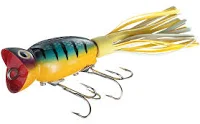Reprinted from The Sioux City Journal
The first time I used a drop-shot rig was back in November of 2000. It was the hottest rig on the pro bass fishing scene at the time.
In fact, it had become a much-guarded secret among a few bass pros until two major tournaments were won with the system in 1999.
Barry Day, Sibley, Iowa, was at the time a Pure Fishing Inc. rep who attended most of the big tournaments promoting Pure Fishing products. He learned this system, which was perfected by Japanese fishermen before it came here, from the pros.
After a day of fishing the technique with Barry, I became convinced that this was a fishing system that had tremendous potential for not only bass, but walleyes, perch and other panfish.
I was sure the drop shot would become as popular as the lead head jig.
Well, I was wrong.
It just never seemed to catch on with most anglers. Of course a few made it a strong part of their bass fishing, and there may be a few using it for walleyes and panfish.
But most don’t. And I think that is a mistake.
The original drop shot rig set-up was a finesse fishing approach. Light line, small hooks, a split shot for a sinker and tiny, 4-inch plastics.
But it is much more than that. You can fish this rig with heavy line, a stiff rod, big hooks and big sinkers. More about this later.
For those not familiar with the drop shot rig, here’s what it is. Initially we used Eagle Claw number 2 hooks, gold plated. These are light wire, Aberdeen bend, long shanked hooks for panfish.
The key to making this rig is to tie the hook on with a Palomar knot. Here’s how: hold the hook so the point is up, run about two feet of line down through the eye of the hook and bring it back through the same hole. Pull it through until you have about a 2- or 3-inch loop of line left. Then simply tie and over hand knot using the loop, then slip your hook through the loop and tighten the knot to the hook eye. Next take the tag end of the line and run it back through the eye of the hook. Pull the line tight and the hook should stand out away from the line, point up.
Then pinch on a large split shot, but not so tightly that it cannot slip off the line. If you become snagged, you will lose the sinker, but not the whole rig.
I usually have the sinker about 15 inches below the hook for bass fishing. For perch I go about 4 inches. If I mark walleyes off the bottom with my graph I’ll put the sinker about 12 inches off bottom.
If you use a dipsy sinker (sometimes called a bass sinker) tie the line on with a three wrap clinch knot. If the sinker becomes snagged it will slip off the line.
Here’s another method. Use a sliding bass sinker on the line and pinch a split shot on below it.
If you want, you may buy special sinkers created just for drop shot sinking. They come in a variety of styles and some have pinched eyes so you can run your line through them and then cinch it down tight.
One of the biggest drawbacks of drop shotting is that it twists your line. Some anglers tie a small swivel to their line about 15 inches up from the hook. That helps. VMC make a special “Spinshot” hook in a couple different styles. For walleyes and bass using more aggressive presentation techniques, I really like their Spinshot Wide Gap hook. A small swivel above and below the hook prevents much line twist.
Blackmore makes a “StandOut” hook which insures your hook will stand away from the line. They work well.
The original drop shooting method involved fishing directly under the boat or slightly behind as you moved slowly over the structure with the electric motor.
You would simply “quiver” the rod tip and that would cause your 4-inch soft plastic to move enticingly. Strikes are usually hard and easily felt.
But, using a heavier sinker and bigger hook, a regular bass worm hook works well, you can cast this rig to docks, weed beds or brush piles and swim it over the structures.
Some anglers tie a lead head jig to the dropper line instead of a sinker. If you are fishing areas that are not snaggy and it is legal in the state you are fishing, it is a good method especially for walleyes and crappies. Simply put a live minnow on the drop shot hook and tip with same if you want on the jig.
I’ve used drop shot rigs for everything from bluegills to bass. If drop shotting is not an arrow in you presentation quiver, it should be. Give it a try and see if you don’t agree.
More outdoors information is found at http://siouxcityjournal.com/sports/recreation/outdoors/





0 Comments